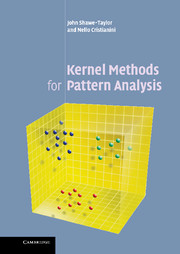Book contents
Preface
Published online by Cambridge University Press: 29 March 2011
Summary
The study of patterns in data is as old as science. Consider, for example, the astronomical breakthroughs of Johannes Kepler formulated in his three famous laws of planetary motion. They can be viewed as relations that he detected in a large set of observational data compiled by Tycho Brahe.
Equally the wish to automate the search for patterns is at least as old as computing. The problem has been attacked using methods of statistics, machine learning, data mining and many other branches of science and engineering.
Pattern analysis deals with the problem of (automatically) detecting and characterising relations in data. Most statistical and machine learning methods of pattern analysis assume that the data is in vectorial form and that the relations can be expressed as classification rules, regression functions or cluster structures; these approaches often go under the general heading of ‘statistical pattern recognition’. ‘Syntactical’ or ‘structural pattern recognition’ represents an alternative approach that aims to detect rules among, for example, strings, often in the form of grammars or equivalent abstractions.
The evolution of automated algorithms for pattern analysis has undergone three revolutions. In the 1960s efficient algorithms for detecting linear relations within sets of vectors were introduced. Their computational and statistical behaviour was also analysed. The Perceptron algorithm introduced in 1957 is one example. The question of how to detect nonlinear relations was posed as a major research goal at that time.
- Type
- Chapter
- Information
- Kernel Methods for Pattern Analysis , pp. xi - xivPublisher: Cambridge University PressPrint publication year: 2004

